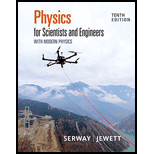
Physics for Scientists and Engineers with Modern Physics
10th Edition
ISBN: 9781337553292
Author: Raymond A. Serway, John W. Jewett
Publisher: Cengage Learning
expand_more
expand_more
format_list_bulleted
Concept explainers
Question
Chapter 13, Problem 24AP
(a)
To determine
To determine: The maximum distance of the rocket from the Earth’s surface.
(b)
To determine
To determine: Whether the maximum distance covered by rocket from the surface be larger if it is launched from the equator.
Expert Solution & Answer
Want to see the full answer?
Check out a sample textbook solution
Students have asked these similar questions
The cylindrical beam of a 12.7-mW laser is 0.920 cm in diameter. What is the rms value of the electric field?
V/m
Consider a rubber rod that has been rubbed with fur to give the rod a net negative charge, and a glass rod that has been rubbed with silk to give it a net positive charge. After being charged by contact by the fur and silk...?
a. Both rods have less mass
b. the rubber rod has more mass and the glass rod has less mass
c. both rods have more mass
d. the masses of both rods are unchanged
e. the rubber rod has less mass and the glass rod has mroe mass
8) 9)
Chapter 13 Solutions
Physics for Scientists and Engineers with Modern Physics
Ch. 13.1 - A planet has two moons of equal mass. Moon 1 is in...Ch. 13.2 - Prob. 13.2QQCh. 13.4 - Prob. 13.3QQCh. 13.6 - Prob. 13.4QQCh. 13 - Prob. 1PCh. 13 - During a solar eclipse, the Moon, the Earth, and...Ch. 13 - Determine the order of magnitude of the...Ch. 13 - Prob. 4PCh. 13 - Review. Miranda, a satellite of Uranus, is shown...Ch. 13 - (a) Compute the vector gravitational field at a...
Ch. 13 - A spacecraft in the shape of a long cylinder has a...Ch. 13 - An artificial satellite circles the Earth in a...Ch. 13 - Prob. 9PCh. 13 - A particle of mass m moves along a straight line...Ch. 13 - Use Keplers third law to determine how many days...Ch. 13 - Prob. 12PCh. 13 - Suppose the Suns gravity were switched off. The...Ch. 13 - (a) Given that the period of the Moons orbit about...Ch. 13 - How much energy is required to move a 1 000-kg...Ch. 13 - An object is released from rest at an altitude h...Ch. 13 - A system consists of three particles, each of mass...Ch. 13 - Prob. 18PCh. 13 - A 500-kg satellite is in a circular orbit at an...Ch. 13 - Prob. 20PCh. 13 - Prob. 21PCh. 13 - Prob. 22PCh. 13 - Ganymede is the largest of Jupiters moons....Ch. 13 - Prob. 24APCh. 13 - Voyager 1 and Voyager 2 surveyed the surface of...Ch. 13 - Prob. 26APCh. 13 - Prob. 27APCh. 13 - Why is the following situation impossible? A...Ch. 13 - Let gM represent the difference in the...Ch. 13 - A sleeping area for a long space voyage consists...Ch. 13 - Prob. 31APCh. 13 - Prob. 32APCh. 13 - Prob. 33APCh. 13 - Two spheres having masses M and 2M and radii R and...Ch. 13 - (a) Show that the rate of change of the free-fall...Ch. 13 - A certain quaternary star system consists of three...Ch. 13 - Studies of the relationship of the Sun to our...Ch. 13 - Review. Two identical hard spheres, each of mass m...Ch. 13 - Prob. 39APCh. 13 - Prob. 40APCh. 13 - Prob. 41APCh. 13 - Prob. 42APCh. 13 - As thermonuclear fusion proceeds in its core, the...Ch. 13 - Two stars of masses M and m, separated by a...Ch. 13 - The Solar and Heliospheric Observatory (SOHO)...
Knowledge Booster
Learn more about
Need a deep-dive on the concept behind this application? Look no further. Learn more about this topic, physics and related others by exploring similar questions and additional content below.Similar questions
- Lab 8 Part 3 PHET Wave Interface simulation. I am having trouble with this part of the lab.arrow_forwardMick and Rick are twins born on Earth in the year 2175. Rick grows up to be an Earth-bound robotics technician while Mick becomes an intergalactic astronaut. Mick leaves the Earth on his first space mission in the year 2200 and travels, according to his clock, for 10 years at a speed of 0.75c. Unfortunately, at this point in his journey, the structure of his ship undergoes mechanical breakdown and the ship explodes. How old is Rick when his brother dies?arrow_forwardHi, I have canceled, why did you charge me again?arrow_forward
arrow_back_ios
SEE MORE QUESTIONS
arrow_forward_ios
Recommended textbooks for you
 Principles of Physics: A Calculus-Based TextPhysicsISBN:9781133104261Author:Raymond A. Serway, John W. JewettPublisher:Cengage Learning
Principles of Physics: A Calculus-Based TextPhysicsISBN:9781133104261Author:Raymond A. Serway, John W. JewettPublisher:Cengage Learning Classical Dynamics of Particles and SystemsPhysicsISBN:9780534408961Author:Stephen T. Thornton, Jerry B. MarionPublisher:Cengage Learning
Classical Dynamics of Particles and SystemsPhysicsISBN:9780534408961Author:Stephen T. Thornton, Jerry B. MarionPublisher:Cengage Learning University Physics Volume 1PhysicsISBN:9781938168277Author:William Moebs, Samuel J. Ling, Jeff SannyPublisher:OpenStax - Rice University
University Physics Volume 1PhysicsISBN:9781938168277Author:William Moebs, Samuel J. Ling, Jeff SannyPublisher:OpenStax - Rice University Physics for Scientists and Engineers: Foundations...PhysicsISBN:9781133939146Author:Katz, Debora M.Publisher:Cengage Learning
Physics for Scientists and Engineers: Foundations...PhysicsISBN:9781133939146Author:Katz, Debora M.Publisher:Cengage Learning Physics for Scientists and Engineers, Technology ...PhysicsISBN:9781305116399Author:Raymond A. Serway, John W. JewettPublisher:Cengage Learning
Physics for Scientists and Engineers, Technology ...PhysicsISBN:9781305116399Author:Raymond A. Serway, John W. JewettPublisher:Cengage Learning College PhysicsPhysicsISBN:9781285737027Author:Raymond A. Serway, Chris VuillePublisher:Cengage Learning
College PhysicsPhysicsISBN:9781285737027Author:Raymond A. Serway, Chris VuillePublisher:Cengage Learning

Principles of Physics: A Calculus-Based Text
Physics
ISBN:9781133104261
Author:Raymond A. Serway, John W. Jewett
Publisher:Cengage Learning

Classical Dynamics of Particles and Systems
Physics
ISBN:9780534408961
Author:Stephen T. Thornton, Jerry B. Marion
Publisher:Cengage Learning

University Physics Volume 1
Physics
ISBN:9781938168277
Author:William Moebs, Samuel J. Ling, Jeff Sanny
Publisher:OpenStax - Rice University

Physics for Scientists and Engineers: Foundations...
Physics
ISBN:9781133939146
Author:Katz, Debora M.
Publisher:Cengage Learning

Physics for Scientists and Engineers, Technology ...
Physics
ISBN:9781305116399
Author:Raymond A. Serway, John W. Jewett
Publisher:Cengage Learning

College Physics
Physics
ISBN:9781285737027
Author:Raymond A. Serway, Chris Vuille
Publisher:Cengage Learning